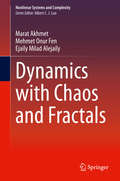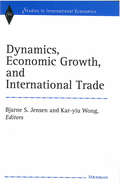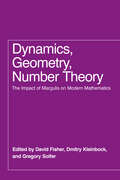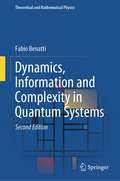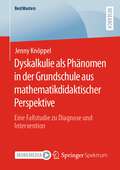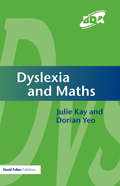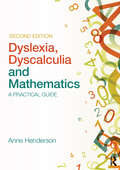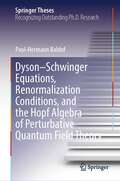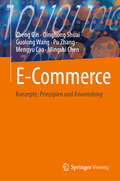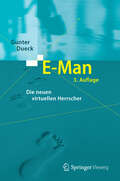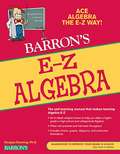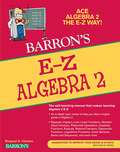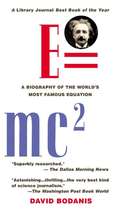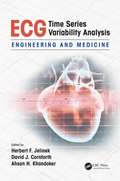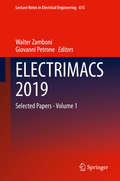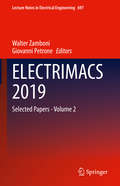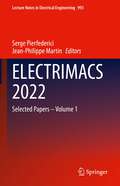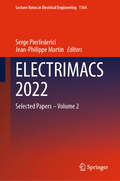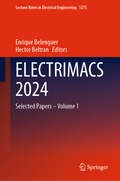- Table View
- List View
Dynamics with Chaos and Fractals (Nonlinear Systems and Complexity #29)
by Marat Akhmet Mehmet Onur Fen Ejaily Milad AlejailyThe book is concerned with the concepts of chaos and fractals, which are within the scopes of dynamical systems, geometry, measure theory, topology, and numerical analysis during the last several decades. It is revealed that a special kind of Poisson stable point, which we call an unpredictable point, gives rise to the existence of chaos in the quasi-minimal set. This is the first time in the literature that the description of chaos is initiated from a single motion. Chaos is now placed on the line of oscillations, and therefore, it is a subject of study in the framework of the theories of dynamical systems and differential equations, as in this book. The techniques introduced in the book make it possible to develop continuous and discrete dynamics which admit fractals as points of trajectories as well as orbits themselves. To provide strong arguments for the genericity of chaos in the real and abstract universe, the concept of abstract similarity is suggested.
Dynamics, Economic Growth, and International Trade
by Bjarne S. Jensen Kar-Yiu WongWhile endogenous growth theory has claimed success in modeling various factors of growth and providing an analysis of sustainable economic growth, most of the growth models in published work are for closed economies. The omission of international trade, which is often regarded as the engine of growth, greatly reduces their usefulness. The theory of international trade, on the other hand, is characterized by models that are mainly static. While interest in the dynamics of trade has been growing, there is still little work in this area. The success of the newly industrialized economies that have adopted trade-oriented policies suggests how limited present trade theory is in explaining and analyzing the growth of these economies. The work collected here serves to bridge the "old" growth theory and "new" growth theory; merge growth and trade theory; suggest new analysis and techniques of economic growth; and provide analysis of new issues related to growth and trade. The first chapter surveys endogenous growth and international trade and critically reviews the endogenous growth theory with a unified framework, covering the work on both closed and open economies. Three chapters examine the dynamics of some basic trade models; two chapters focus on growth and trade with endogenous accumulation of human and public capital; two chapters on economic growth, technological progress, and international trade; and two chapters on growth and international factor movements.
Dynamics, Games and Science
by Marcelo Viana Jean-Pierre Bourguignon Alberto Adrego Pinto Rolf JeltschThe focus of this volume is research carried out as part of the program Mathematics of Planet Earth, which provides a platform to showcase the essential role of mathematics in addressing problems of an economic and social nature and creating a context for mathematicians and applied scientists to foster mathematical and interdisciplinary developments that will be necessary to tackle a myriad of issues and meet future global economic and social challenges. Earth is a planet with dynamic processes in its mantle, oceans and atmosphere creating climate, causing natural disasters and influencing fundamental aspects of life and life-supporting systems. In addition to these natural processes, human activity has developed highly complex systems, including economic and financial systems; the World Wide Web; frameworks for resource management, transportation, energy production and utilization; health care delivery, and social organizations. This development has increased to the point where it impacts the stability and equilibrium in human societies. Issues such as financial and economic crisis, sustainability, management of resources, risk analysis, and global integration have come to the fore. Written by some of the world's leading specialists, this book presents the proceedings of the International Conference and Advanced School Planet Earth, Dynamics, Games and Science II, held in Lisbon, Portugal, 28 August -6 September 2013, which was organized by the International Center of Mathematics (CIM) as a partner institution of the international program Mathematics of Planet Earth 2013. The book describes the state of the art in advanced research and ultimate techniques in modeling natural, economic and social phenomena. It constitutes a tool and a framework for researchers and graduate students, both in mathematics and applied sciences, focusing mainly on dynamical systems, game theory and applied sciences.
Dynamics, Geometry, Number Theory: The Impact of Margulis on Modern Mathematics
by David Fisher, Dmitry Kleinbock, and Gregory SoiferThis definitive synthesis of mathematician Gregory Margulis’s research brings together leading experts to cover the breadth and diversity of disciplines Margulis’s work touches upon. This edited collection highlights the foundations and evolution of research by widely influential Fields Medalist Gregory Margulis. Margulis is unusual in the degree to which his solutions to particular problems have opened new vistas of mathematics; his ideas were central, for example, to developments that led to the recent Fields Medals of Elon Lindenstrauss and Maryam Mirzhakhani. Dynamics, Geometry, Number Theory introduces these areas, their development, their use in current research, and the connections between them. Divided into four broad sections—“Arithmeticity, Superrigidity, Normal Subgroups”; “Discrete Subgroups”; “Expanders, Representations, Spectral Theory”; and “Homogeneous Dynamics”—the chapters have all been written by the foremost experts on each topic with a view to making them accessible both to graduate students and to experts in other parts of mathematics. This was no simple feat: Margulis’s work stands out in part because of its depth, but also because it brings together ideas from different areas of mathematics. Few can be experts in all of these fields, and this diversity of ideas can make it challenging to enter Margulis’s area of research. Dynamics, Geometry, Number Theory provides one remedy to that challenge.
Dynamics, Information and Complexity in Quantum Systems (Theoretical and Mathematical Physics)
by Fabio BenattiThis second edition of Dynamics, Information and Complexity in Quantum Systems widens its scope by focussing more on the dynamics of quantum correlations and information in microscopic and mesoscopic systems, and their use for metrological and machine learning purposes. The book is divided into three parts: Part One: Classical Dynamical SystemsAddresses classical dynamical systems, classical dynamical entropy, and classical algorithmic complexity.Includes a survey of the theory of simple perceptrons and their storage capacity. Part Two: Quantum Dynamical SystemsFocuses on the dynamics of entanglement under dissipative dynamics and its metrological use in finite level quantum systems.Discusses the quantum fluctuation approach to large-scale mesoscopic systems and their emergent dynamics in quantum systems with infinitely many degrees of freedom.Introduces a model of quantum perceptron whose storage capacity is computed and compared with the classical one. Part Three: Quantum Dynamical Entropies and ComplexitiesDevoted to quantum dynamical entropies and algorithmic complexities. This book is meant for advanced students, young and senior researchers working in the fields of quantum statistical mechanics, quantum information, and quantum dynamical systems. It is self-contained, and the only prerequisites needed are a standard knowledge of statistical mechanics, quantum mechanics, and linear operators on Hilbert spaces.
Dynamics: A Lecturebook
by Charles M. Krousgrill Jeffrey F. RhoadsThis hybrid of textbook and lecture notes set is designed to provide an undergraduate-level, engineering-focused introduction to the topic of dynamics. To this end, the text covers the following key topical areas: Particle and Rigid Body Kinematics, including Cartesian, path, polar, and cylindrical descriptions of motion; relative and constrained motion; vector kinematics; instantaneous centers of rotation; and 2D and 3D moving reference frames. Particle and Rigid Body Kinetics, including Newtons Laws of Motion; the work-energy equation; and the linear and angular impulse-momentum equations. Introduction to Mechanical Vibrations, including equation of motion development; free vibration response; harmonic forced vibrations; base excitation; and rotating imbalance, all as applied to single-degree-of-freedom systems. The text provides pertinent background information, while emphasizing fundamental engineering principles, conceptual understanding, and optimal problem solving techniques. The Lecturebook also incorporates an extensive array of practical examples with which students can hone their skills. Key distinctions between the Lecturebook and most conventional texts include: Complete integration of factual information and student-produced notes. Removal of extraneous factual information. The inclusion of conceptual problems designed to exercise higher levels of learning. Lecture example, homework solution, and demonstration videos designed to aid asynchronous learning. The hybrid textbook/lecture note format provides most factual information in full, while brief and extended examples are provided with ample white space, allowing students to actively work the problems with the instructor s assistance in a classroom environment, or outside of the classroom on their own or with the assistance of online videos.
Dynamis: Ontology of the Incommensurable (Contributions to Hermeneutics #9)
by Gaetano ChiurazziThis book offers a new and original hypothesis on the origin of modal ontology, whose roots can be traced back to the mathematical debate about incommensurable magnitudes, which forms the implicit background for Plato’s later dialogues and culminates in the definition of being as dynamis in the Sophist. Incommensurable magnitudes – also called dynameis by Theaetetus – are presented as the solution to the problem of non-being and serve as the cornerstone for a philosophy of difference and becoming. This shift also marks the passage to another form of rationality – one not of the measure, but of the mediation. The book argues that the ontology and the rationality which arise out of the discovery of incommensurable constitutes a thread that runs through the entire history of philosophy, one that leads to Kantian transcendentalism and to the philosophies derived from it, such as Hegelianism and philosophical hermeneutics.Readers discover an insightful exchange with some of the most important issues in philosophy, newly reconsidered from the point of view of an ontology of the incommensurable. These issues include the infinite, the continuum, existence, and difference. This text appeals to students and researchers in the fields of ancient philosophy, German idealism, philosophical hermeneutics and the history of mathematics.
Dyskalkulie als Phänomen in der Grundschule aus mathematikdidaktischer Perspektive: Eine Fallstudie zu Diagnose und Intervention (BestMasters)
by Jenny KnöppelDas vorliegende Buch beschäftigt sich mit der Thematik der Dyskalkulie aus einer mathematikdidaktischen Perspektive. Den Kern bildet dabei eine Fallstudie mit einer Grundschülerin, bei der zuvor eine Dyskalkulie diagnostiziert wurde. Im Sinne des Case-Study-Ansatzes liegt der Fokus auf der genauen Beschreibung und Analyse des Falls unter Berücksichtigung verschiedener Datenquellen. Dazu werden im Verlauf der Studie Diagnosetests, Experteninterviews mit den Eltern, der Lehrperson und der Schülerin, sowie Analysen von Lösungsskizzen durchgeführt. Im Rahmen der Interviews und diagnostischer Gespräche mit der Schülerin werden insbesondere ihre Denkweisen und Lösungsprozesse beobachtet, beschrieben und somit die Kompetenzen und mögliche Hürden im Bereich der Arithmetik identifiziert. Auf Grundlage der Erkenntnisse aus den Diagnoseeinheiten werden entsprechende Interventionseinheiten konzipiert. Der Schwerpunkt der Beobachtungen und Analysen orientiert sich dabei an der Frage nach den Lernfortschritten, die sich im Verlauf der Förderung beschreiben lassen. Ziel dieser Studie ist es, einen Ansatz zu einem „ganzheitlichen“ Bild eines Falls zu skizzieren, um Perspektiven für Diagnose- und Fördermöglichkeiten aufzuzeigen und weitere Forschungsfragen und -anliegen zu generieren.
Dyslexia and Maths
by Dorian Yeo Julie KayThis concise text helps the reader to understand why dyslexics find maths difficult and offers practical ideas for supporting them most effectively. It explains which areas of maths dyslexics tend to have particular difficulty with, assesses current teaching philosophies and methods, describes a framework of general learning principles that allow dyslexics to make progress in maths, and outlines a number of specific and effective teaching recommendations. The book helps teachers at primary and secondary levels to better understand the maths performance of dyslexics and gives them an overview of the ways in which dyslexics can best be supported in all aspects of maths learning.
Dyslexia, Dyscalculia and Mathematics: A practical guide
by Anne HendersonDyslexia, Dyscalculia and Mathematics will be an essential resource for teachers, classroom assistants, and SENCOs who help dyslexic and dyscalculic children with their understanding of mathematics. Written in an accessible style with helpful illustrations, this practical book reveals helpful ways in which to tackle both simple and complex concepts with students of all ages. This second edition has been updated to include references to using technology that will help children with dyslexia and dyscalculia reinforce their mathematical skills and also contains a number of photocopiable resources that can be used in the classroom. Written by Anne Henderson, who is experienced in teaching language and mathematics to pupils with dyslexia and dyscalculia, this book outlines current thinking in the field and shows how the research methods that have been proven as successful can be used with whole classes of children. This book encourages flexible methods and gives teachers the confidence to discuss alternative solutions with their pupils and help them achieve success. It is an ideal handbook for parent-teacher programmes and is also suitable for in-service training.
Dyson–Schwinger Equations, Renormalization Conditions, and the Hopf Algebra of Perturbative Quantum Field Theory (Springer Theses)
by Paul-Hermann BaldufThis book offers a systematic introduction to the Hopf algebra of renormalization in quantum field theory, with a special focus on physical motivation, the role of Dyson–Schwinger equations, and the renormalization group. All necessary physical and mathematical constructions are reviewed and motivated in a self-contained introduction. The main part of the book concerns the interplay between Dyson–Schwinger equations (DSEs) and renormalization conditions. The book is explicit and consistent about whether a statement is true in general or only in particular renormalization schemes or approximations and about the dependence of quantities on regularization parameters or coupling constants. With over 600 references, the original literature is cited whenever possible and the book contains numerous references to other works discussing further details, generalizations, or alternative approaches. There are explicit examples and remarks to make the connection from the scalar fields at hand toQED and QCD. The book is primarily targeted at the mathematically oriented physicist who seeks a systematic conceptual overview of renormalization, Hopf algebra, and DSEs. These may be graduate students entering the field as well as practitioners seeking a self-contained account of the Hopf algebra construction. Conversely, the book also benefits the mathematician who is interested in the physical background of the exciting interplay between Hopf algebra, combinatorics and physics that is renormalization theory today.
E-Commerce: Konzepte, Prinzipien und Anwendung
by Zheng Qin Guolong Wang Qinghong Shuai Pu Zhang Mengyu Cao Mingshi ChenDieses Buch behandelt hauptsächlich den Hintergrund des E-Commerce, das Grundwissen des E-Commerce, die Grundmodelle des E-Commerce, die Grundprinzipien des E-Commerce und die Fälle des E-Commerce. Dieses Buch hat ein theoretisches System des E-Commerce mit klaren Integrationsgrenzen gebildet. Die Einführung der systematischen Theorie wird durch den Hintergrund des E-Commerce geleitet, zentriert sich auf das Modell des E-Commerce, wird mit den Prinzipien des E-Commerce untermauert und mit den neuesten Fällen integriert. Dieses Buch definiert die grundlegenden Konzepte, Modelle und Prinzipien des E-Commerce in Form einer mathematischen Analyse und analysiert die Grundtheorie des E-Commerce aus der Perspektive des mathematischen Modells. Dies ermöglicht den Lesern, ein abstraktes Verständnis der Konnotation und Erweiterung des E-Commerce zu entwickeln. Es etabliert ein Wissenssystem mit dem Hintergrund der sozialen Ökologie, der Ingenieurökologie und der Innovationsökologie, wobei die Modelle des E-Commerce als Kern, die Prinzipien des E-Commerce als Prozess, die Architektur des E-Commerce als Plattform und der Betrieb und das Management des E-Commerce als Mittel zur Integration des Wissens in die Anwendung dienen. Dieses Buch verwendet Fallstudien, um das Wissenssystem, das den E-Commerce betrifft, umfassend zu analysieren und anzuwenden und kombiniert theoretische Forschung mit Ingenieurforschung. Durch dieses Buch können die Leser systematisch alle Arten von Theorien, die den E-Commerce betreffen, meistern. Dieses Buch richtet sich an verschiedene professionelle und diverse Lesergruppen. Es kann als Grundlagenbuch für Studenten verschiedener E-Commerce-bezogener Fachrichtungen verwendet werden.
E-Learning in the Middle East and North Africa (MENA) Region
by Alan S. Weber Sihem HamlaouiIn the last decade, due to factors of ICT infrastructural and broadband maturation, rising levels of educational attainment and computer literacy, and diversification strategies, e-learning has exploded in the Middle East and North Africa (MENA) region. However, significant barriers remain in the region’s e-learning development: lack of research on outcomes and effectiveness, paucity of Arabic language learning objects, monopolies and high cost of telecommunications, cultural taboos, accreditation, censorship, and teacher training.This unique volume is the first comprehensive effort to describe the history, development, and current state of e-learning in each of the 20 MENA countries from Algeria to Yemen. Each entry is expertly written by a specialist who is acutely familiar with the state of e-learning in their respective country, and concludes with a bibliography of key reports, peer-reviewed books and articles, and web resources.E-Learning in the Middle East and North Africa (MENA) proves itself as a vital compendium for a wide readership that includes academics and students, transnational program directors, international education experts, MENA government departments, commercial vendors and investors, and ICT development and regulatory agencies involved in e-learning in the Middle East.
E-Man
by Gunter DueckDie Haupteigenschaften des in der Wirtschaft "ausschlaggebenden" Menschen werden sich ändern. Wir verlassen die "Bauerngesellschaft" der ruhigen, pflichttreuen Menschen, die Tradition, Erfahrung und Orndung herrschen lassen (Old Economy). die neue Zeit "kämpft" mit neuen Geschäftsmodellen und immer schnelleren Technologiezyklen um die Milliarden, die der Erste im Markt erringen kann. Keine Zeit mehr für Erfahrung & Co. Wie wird das sein - in E-Man's World? Besser? Mit 40 Millionär oder Burnout? Wie lange tobt der Umbruch? E-Man muss vor allem kreativ, proaktiv, authentisch, erneuerungs- und risikofähig sein, voller Verrtrauen im stärksten Wandel. Ein Bericht aus der Turbulenzzone des Managements und des Innermenschlichen. Wie gewohnt spannend, provokativ, streitbar und leidenschaftlich subjektiv! Die dritte Auflage wurde um ein Nachwort des Autors ergänzt.
E-Z Algebra (Barron's Easy Series)
by Douglas Downing Peter Eisen<p>Topics covered in this detailed review of algebra include general rules for dealing with numbers, equations, negative numbers and integers, fractions and rational numbers, exponents, roots and real numbers, algebraic expressions, functions, graphs, systems of two equations, quadratic equations, circles, ellipses, parabolas, polynomials, numerical series, permutations, combinations, the binomial formula, proofs by mathematical induction, exponential functions and logarithms, simultaneous equations and matrices, and imaginary numbers. Exercises follow each chapter with answers at the end of the book. <p>Barron's continues its ongoing project of updating, improving, and giving handsome new designs to its popular list of Easy Way titles, now re-named Barron's E-Z Series. The new cover designs reflect the books' brand-new page layouts, which feature extensive two-color treatment, a fresh, modern typeface, and more graphic material than ever. Charts, graphs, diagrams, instructive line illustrations, and where appropriate, amusing cartoons help to make learning E-Z. Barron's E-Z books are self-teaching manuals focused to improve students' grades across a wide array of academic and practical subjects. For most subjects, the skill level ranges between senior high school and college-101 standards. In addition to their self-teaching value, these books are also widely used as textbooks or textbook supplements in classroom settings. E-Z books review their subjects in detail, using both short quizzes and longer tests to help students gauge their learning progress. All exercises and tests come with answers. Subject heads and key phrases are set in a second color as an easy reference aid.</p>
E-Z Algebra 2 (Fifth Edition)
by Meg Clemens Glenn ClemensThis new title in Barron's E-Z Series covers the following topics: Linear Functions, Absolute Value Functions, Polynomial Operations, Quadratic Functions, Complex Numbers, Functions and Relations, Polynomial Functions, Radicals, Rational Functions, Exponential Functions, Logarithmic Functions, Series and Sequences, and Statistics and Modeling. Review exercises are at the end of each chapter.
E.T. Talk
by Fernando J. BallesterosWill it be possible to communicate with intelligent extraterrestrial life forms if we find them? How could we establish this communication, where would we begin? What does it mean to say that mathematics is a universal language? How could math be used to communicate with ETs? This book summarizes the work of SETI, the Search for Extraterrestrial Intelligence, and other search programs and considers the implications of, and concerns about, their possible success. Surely the next step after finding life elsewhere would be to try to communicate with it. The author of this book will suggest concrete ways to approach this problem. This book, published in Spanish first, tells us what scientists currently know about the origin of life and its possible presence in the rest of the universe. It also describes the various methods used today to search for life in the universe. But the major focus of the book is on communicating with ET and, using animals on Earth as an example, why we should feel encouraged that we will be able to do just that. The author even provides step by step instructions in a kind of language that could be used to converse with intelligent alien beings.
E=mc2: A Biography of the World's Most Famous Equation
by David BodanisAlready climbing the bestseller lists-and garnering rave reviews-this "little masterpiece" sheds brilliant light on the equation that changed the world. Bodanis begins by devoting chapters to each of the equation's letters and symbols, introducing the science and scientists forming the backdrop to Einstein's discovery-from Ole Roemer's revelation that the speed of light could be measured to Michael Faraday's pioneering work on energy fields. Having demystified the equation, Bodanis explains its science and brings it to life historically, making clear the astonishing array of discoveries and consequences it made possible. It would prove to be a beacon throughout the twentieth century, important to Ernest Rutherford, who discovered the structure of the atom, Enrico Fermi, who probed the nucleus, and Lise Meitner, who finally understood how atoms could be split wide open. And it has come to inform our daily lives, governing everything from the atomic bomb to a television's cathode-ray tube to the carbon dating of prehistoric paintings.
ECG Time Series Variability Analysis: Engineering and Medicine
by Herbert F. Jelinek David J. Cornforth Ahsan H. KhandokerDivided roughly into two sections, this book provides a brief history of the development of ECG along with heart rate variability (HRV) algorithms and the engineering innovations over the last decade in this area. It reviews clinical research, presents an overview of the clinical field, and the importance of heart rate variability in diagnosis. The book then discusses the use of particular ECG and HRV algorithms in the context of clinical applications.
ECO 219 Samagralakshyi Arthashastra S.Y.B.A - Y.C.M.O.U
by Shri. C. P. Kher Prof. Sau. Anita Gogate Prof. Dr. Sau. Vidya Sohoni Umesh RajaderkarSamagralakshyi Arthashastra ECO 219 textbook for S.Y.B.A. from Yashwantrao Chavan Maharashtra Mukta Vidyapith, Nashik in Marathi.
ELECTRIMACS 2019: Selected Papers - Volume 1 (Lecture Notes in Electrical Engineering #604)
by Giovanni Petrone Walter ZamboniThis book collects a selection of papers presented at ELECTRIMACS 2019, the 13th international conference of the IMACS TC1 Committee, held in Salerno, Italy, on 21st-23rd May 2019. The conference papers deal with modelling, simulation, analysis, control, power management, design optimization, identification and diagnostics in electrical power engineering. The main application fields include electric machines and electromagnetic devices, power electronics, transportation systems, smart grids, electric and hybrid vehicles, renewable energy systems, energy storage, batteries, supercapacitors and fuel cells, and wireless power transfer. The contributions included in Volume 1 are particularly focused on electrical engineering simulation aspects and innovative applications.
ELECTRIMACS 2019: Selected Papers - Volume 2 (Lecture Notes in Electrical Engineering #697)
by Giovanni Petrone Walter ZamboniThis book collects a selection of papers presented at ELECTRIMACS 2019 - The 13th international conference of the IMACS TC1 Committee, held in Salerno, Italy, on 21st-23rd May 2019. The conference papers deal with modelling, simulation, analysis, control, power management, design optimization, identification and diagnostics in electrical power engineering. The main application fields include electric machines and electromagnetic devices, power electronics, transportation systems, smart grids, electric and hybrid vehicles, renewable energy systems, energy storage, batteries, supercapacitors and fuel cells, wireless power transfer. The contributions included in Volume 2 are particularly focussed on methodological aspects, modelling and applied mathematics in the field of electrical engineering.
ELECTRIMACS 2022: Selected Papers – Volume 1 (Lecture Notes in Electrical Engineering #993)
by Serge Pierfederici Jean-Philippe MartinThis book collects a selection of papers presented at ELECTRIMACS 2021, the 14th international conference of the IMACS TC1 Committee, held in Nancy, France, on 16th-19th May 2022. The conference papers deal with modelling, simulation, analysis, control, power management, design optimization, identification and diagnostics in electrical power engineering. The main application fields include electric machines and electromagnetic devices, power electronics, transportation systems, smart grids, renewable energy systems, energy storage like batteries and supercapacitors, fuel cells, and wireless power transfer. The contributions included in Volume 1 will be particularly focused on electrical engineering simulation aspects and innovative applications.
ELECTRIMACS 2022: Selected Papers – Volume 2 (Lecture Notes in Electrical Engineering #1164)
by Serge Pierfederici Jean-Philippe MartinThis book collects a selection of papers presented at ELECTRIMACS, 2022 the14th international conference of the IMACS TC1 Committee, held in Nancy, France, on 17st-21rd May 2022. The conference papers deal with modelling, simulation, analysis, control, power management, design optimization, identification and diagnostics in electrical power engineering. The main application fields include electric machines and electromagnetic devices, power electronics, transportation systems, smart grids, electric and hybrid vehicles, renewable energy systems, energy storage, batteries, supercapacitors and fuel cells, and wireless power transfer. The contributions included in Volume 2 are particularly focused on methodological aspects, modelling, and applied mathematics in the field of electrical engineering.
ELECTRIMACS 2024: Selected Papers – Volume 1 (Lecture Notes in Electrical Engineering #1275)
by Enrique Belenguer Hector BeltranThis book collects a selection of papers presented at ELECTRIMACS 2024. The conference papers deal with modelling, simulation, analysis, control, power management, design optimization, machine learning techniques, and identification and diagnostics in electrical power engineering. The main application fields include electric machines and electromagnetic devices, power electronics, transportation systems, smart grids, electric and hybrid vehicles, renewable energy and energy storage systems, batteries, supercapacitors and fuel cells, and wireless power transfer, among others. Contributions included in Volume 1 are particularly focused on electrical engineering simulation aspects and innovative applications.
